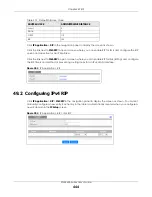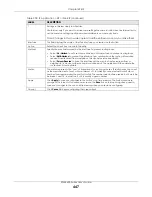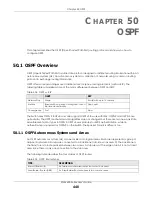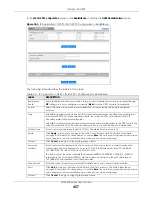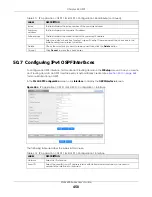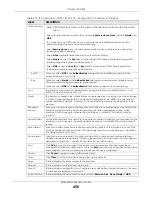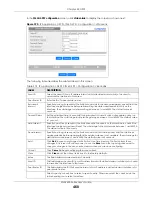
Chapter 50 OSPF
XGS4600 Series User’s Guide
456
50.5.1 View OSPF Area Information Table
The bottom of the
IPv4 OSPF Configuration
screen displays a summary table of all the OSPF areas you
have configured.
Figure 362
IP Application > OSPF > IPv4 OSPF > Configuration: Summary Table
The following table describes the related labels in this screen.
50.6 Configuring IPv4 OSPF Redistribution
Use this screen to configure route redistribution and summary addresses. Route redistribution is used
when other routers which use RIP routing protocol and/or static routes need to exchange routing
information with the Switch using OSPF routing protocol. A summary address is used to cover more than
one routing entries in order to reduce the routing table size.
Add
Click
Add
to save your changes to the Switch’s run-time memory. The Switch loses these
changes if it is turned off or loses power, so use the
Save
link on the top navigation panel to save
your changes to the non-volatile memory when you are done configuring.
Cancel
Click
Cancel
to begin configuring this screen afresh.
Clear
Click
Clear
to reset the fields to default settings.
Table 209 IP Application > OSPF > IPv4 OSPF > Configuration: Area Setup (continued)
LABEL
DESCRIPTION
Table 210 IP Application > OSPF > IPv4 OSPF > Configuration: Summary Table
LABEL
DESCRIPTION
Index
This field displays the index number of an area.
Name
This field displays the descriptive name of an area.
Area ID
This field displays the area ID (that uses the format of an IP address in dotted decimal notation)
that uniquely identifies an area.
An area ID of
0.0.0.0
indicates the backbone.
Authentication
This field displays the authentication method used (
None
,
Simple
or
MD5
).
Stub / NSSA
This field displays the area defined (
Stub
,
NSSA
or
None
).
Select an entry’s check box to select a specific entry. Otherwise, select the check box in the
table heading row to select all entries.
Delete
Click
Delete
to remove the selected entry from the summary table.
Cancel
Click
Cancel
to clear the check boxes.
Содержание XGS4600 Series
Страница 24: ...24 PART I User s Guide ...
Страница 44: ...44 PART II Technical Reference ...
Страница 180: ...Chapter 13 Spanning Tree Protocol XGS4600 Series User s Guide 180 Figure 145 MSTP and Legacy RSTP Network Example ...
Страница 189: ...Chapter 16 Mirroring XGS4600 Series User s Guide 189 Figure 150 Advanced Application Mirroring Standalone Mode ...
Страница 244: ...Chapter 22 Policy Rule XGS4600 Series User s Guide 244 Figure 189 Policy Example EXAMPLE ...
Страница 277: ...Chapter 25 Multicast XGS4600 Series User s Guide 277 Figure 215 Advanced Application Multicast MVR Standalone Mode ...
Страница 559: ...Chapter 59 Access Control XGS4600 Series User s Guide 559 Figure 460 Example Lock Denoting a Secure Connection EXAMPLE ...
Страница 586: ...Chapter 69 Configure Clone XGS4600 Series User s Guide 586 Figure 479 Management Configure Clone Standalone Mode ...
Страница 587: ...Chapter 69 Configure Clone XGS4600 Series User s Guide 587 Figure 480 Management Configure Clone Stacking Mode ...
Страница 594: ...Chapter 71 Port Status XGS4600 Series User s Guide 594 Figure 485 Management Port Status Port Details Standalone Mode ...
Страница 604: ...604 PART III Troubleshooting and Appendices ...



